Study Skills LSME002: Learning Approaches, Brain, and Mind Mapping
VerifiedAdded on 2023/06/13
|8
|3586
|53
Essay
AI Summary
This essay explores various learning approaches, including behavioristic, social, cognitive, experiential, visual, aural, reading/writing, and kinesthetic methods, emphasizing personalized learning strategies like the CREAM strategy. It discusses the importance of time management, stress reduction, and understanding the brain's capabilities, including memory, neurons, and synapses. The essay also covers drivers of brain performance such as exercise, sleep, nutrition, and emotional well-being, along with strategies to improve working memory, executive function, and planning skills. Barriers to effective study, such as mental and emotional blocks, are addressed, highlighting the importance of a positive mindset and communication. Desklib offers a wealth of similar solved assignments and resources for students.
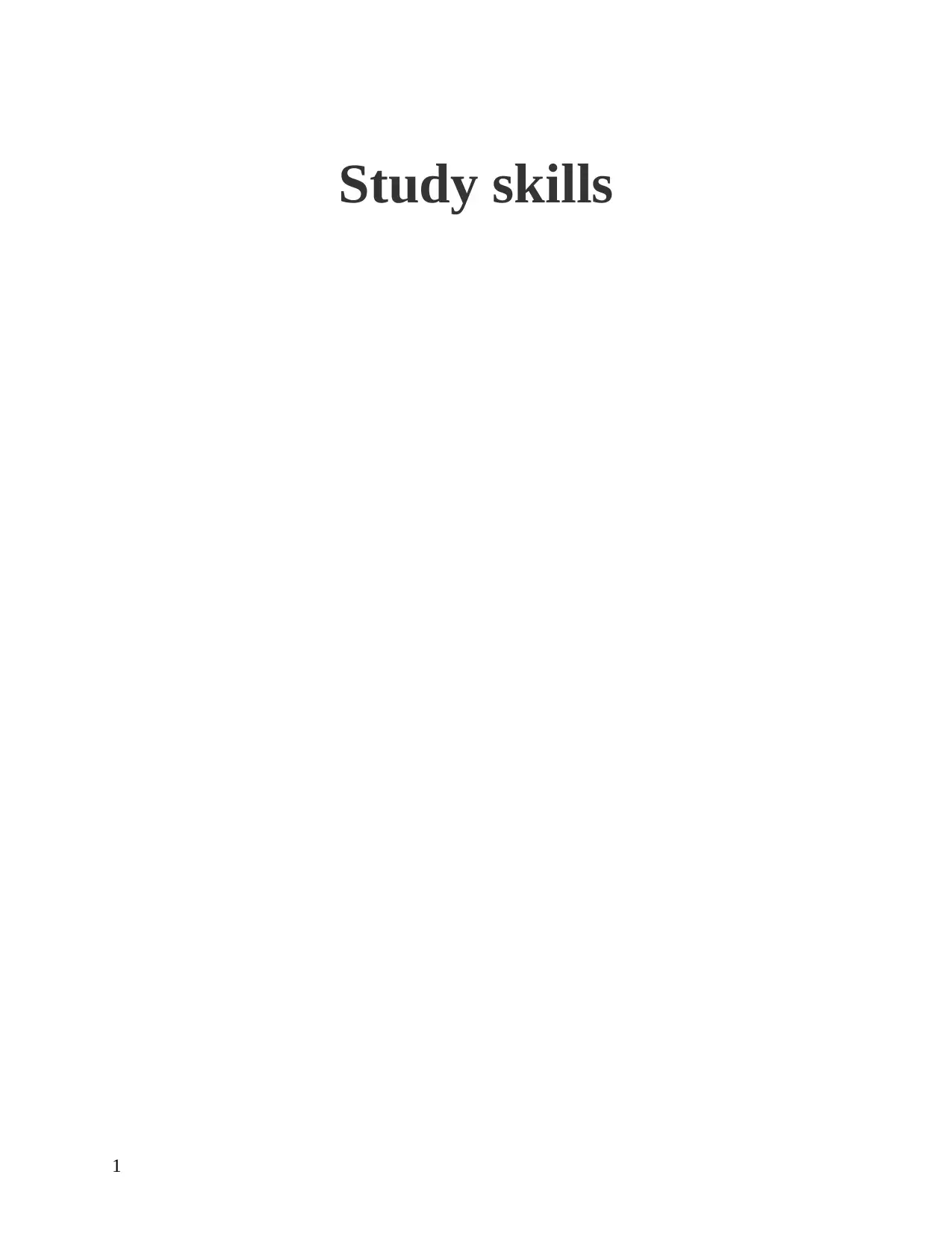
Study skills
1
1
Paraphrase This Document
Need a fresh take? Get an instant paraphrase of this document with our AI Paraphraser
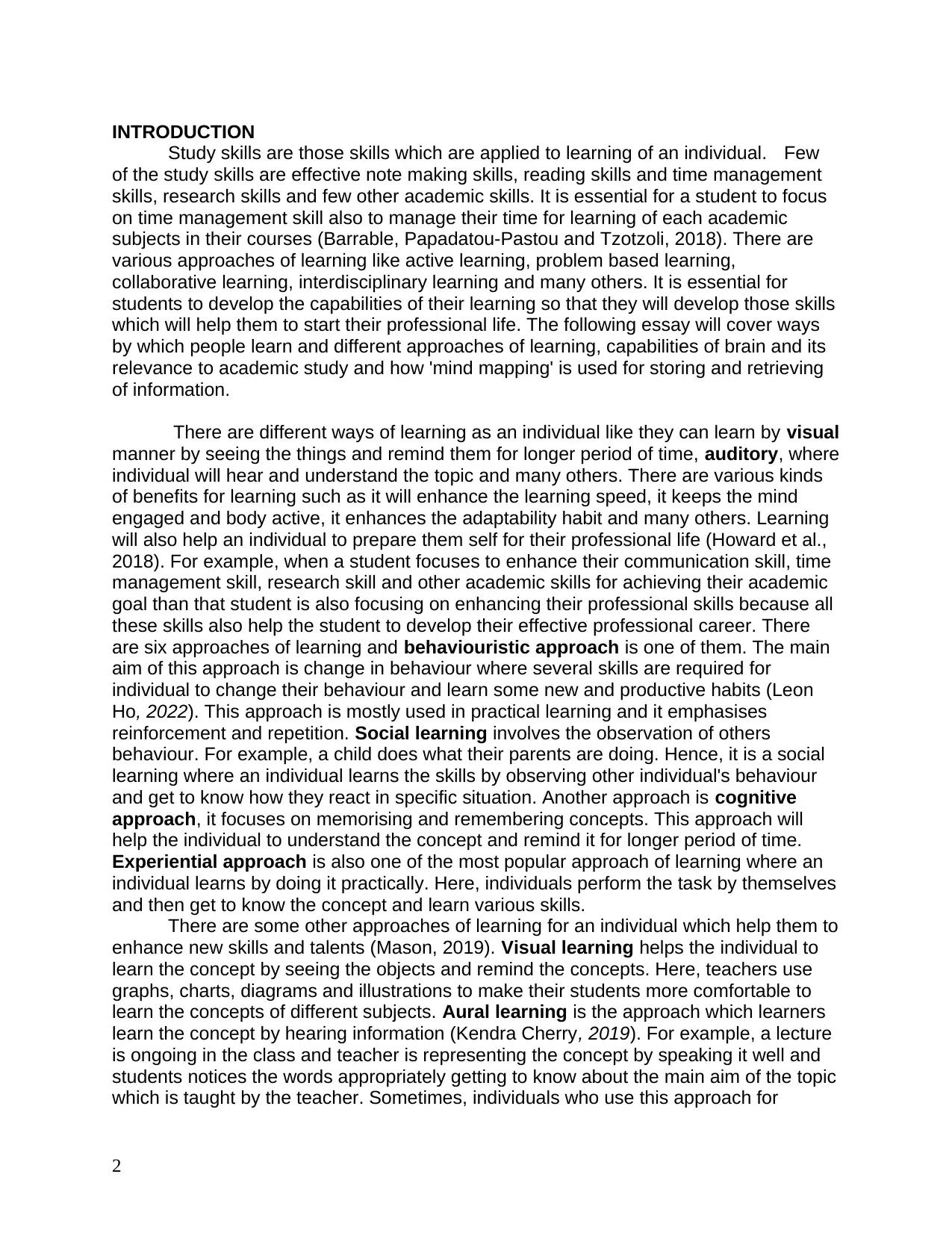
INTRODUCTION
Study skills are those skills which are applied to learning of an individual. Few
of the study skills are effective note making skills, reading skills and time management
skills, research skills and few other academic skills. It is essential for a student to focus
on time management skill also to manage their time for learning of each academic
subjects in their courses (Barrable, Papadatou-Pastou and Tzotzoli, 2018). There are
various approaches of learning like active learning, problem based learning,
collaborative learning, interdisciplinary learning and many others. It is essential for
students to develop the capabilities of their learning so that they will develop those skills
which will help them to start their professional life. The following essay will cover ways
by which people learn and different approaches of learning, capabilities of brain and its
relevance to academic study and how 'mind mapping' is used for storing and retrieving
of information.
There are different ways of learning as an individual like they can learn by visual
manner by seeing the things and remind them for longer period of time, auditory, where
individual will hear and understand the topic and many others. There are various kinds
of benefits for learning such as it will enhance the learning speed, it keeps the mind
engaged and body active, it enhances the adaptability habit and many others. Learning
will also help an individual to prepare them self for their professional life (Howard et al.,
2018). For example, when a student focuses to enhance their communication skill, time
management skill, research skill and other academic skills for achieving their academic
goal than that student is also focusing on enhancing their professional skills because all
these skills also help the student to develop their effective professional career. There
are six approaches of learning and behaviouristic approach is one of them. The main
aim of this approach is change in behaviour where several skills are required for
individual to change their behaviour and learn some new and productive habits (Leon
Ho, 2022). This approach is mostly used in practical learning and it emphasises
reinforcement and repetition. Social learning involves the observation of others
behaviour. For example, a child does what their parents are doing. Hence, it is a social
learning where an individual learns the skills by observing other individual's behaviour
and get to know how they react in specific situation. Another approach is cognitive
approach, it focuses on memorising and remembering concepts. This approach will
help the individual to understand the concept and remind it for longer period of time.
Experiential approach is also one of the most popular approach of learning where an
individual learns by doing it practically. Here, individuals perform the task by themselves
and then get to know the concept and learn various skills.
There are some other approaches of learning for an individual which help them to
enhance new skills and talents (Mason, 2019). Visual learning helps the individual to
learn the concept by seeing the objects and remind the concepts. Here, teachers use
graphs, charts, diagrams and illustrations to make their students more comfortable to
learn the concepts of different subjects. Aural learning is the approach which learners
learn the concept by hearing information (Kendra Cherry, 2019). For example, a lecture
is ongoing in the class and teacher is representing the concept by speaking it well and
students notices the words appropriately getting to know about the main aim of the topic
which is taught by the teacher. Sometimes, individuals who use this approach for
2
Study skills are those skills which are applied to learning of an individual. Few
of the study skills are effective note making skills, reading skills and time management
skills, research skills and few other academic skills. It is essential for a student to focus
on time management skill also to manage their time for learning of each academic
subjects in their courses (Barrable, Papadatou-Pastou and Tzotzoli, 2018). There are
various approaches of learning like active learning, problem based learning,
collaborative learning, interdisciplinary learning and many others. It is essential for
students to develop the capabilities of their learning so that they will develop those skills
which will help them to start their professional life. The following essay will cover ways
by which people learn and different approaches of learning, capabilities of brain and its
relevance to academic study and how 'mind mapping' is used for storing and retrieving
of information.
There are different ways of learning as an individual like they can learn by visual
manner by seeing the things and remind them for longer period of time, auditory, where
individual will hear and understand the topic and many others. There are various kinds
of benefits for learning such as it will enhance the learning speed, it keeps the mind
engaged and body active, it enhances the adaptability habit and many others. Learning
will also help an individual to prepare them self for their professional life (Howard et al.,
2018). For example, when a student focuses to enhance their communication skill, time
management skill, research skill and other academic skills for achieving their academic
goal than that student is also focusing on enhancing their professional skills because all
these skills also help the student to develop their effective professional career. There
are six approaches of learning and behaviouristic approach is one of them. The main
aim of this approach is change in behaviour where several skills are required for
individual to change their behaviour and learn some new and productive habits (Leon
Ho, 2022). This approach is mostly used in practical learning and it emphasises
reinforcement and repetition. Social learning involves the observation of others
behaviour. For example, a child does what their parents are doing. Hence, it is a social
learning where an individual learns the skills by observing other individual's behaviour
and get to know how they react in specific situation. Another approach is cognitive
approach, it focuses on memorising and remembering concepts. This approach will
help the individual to understand the concept and remind it for longer period of time.
Experiential approach is also one of the most popular approach of learning where an
individual learns by doing it practically. Here, individuals perform the task by themselves
and then get to know the concept and learn various skills.
There are some other approaches of learning for an individual which help them to
enhance new skills and talents (Mason, 2019). Visual learning helps the individual to
learn the concept by seeing the objects and remind the concepts. Here, teachers use
graphs, charts, diagrams and illustrations to make their students more comfortable to
learn the concepts of different subjects. Aural learning is the approach which learners
learn the concept by hearing information (Kendra Cherry, 2019). For example, a lecture
is ongoing in the class and teacher is representing the concept by speaking it well and
students notices the words appropriately getting to know about the main aim of the topic
which is taught by the teacher. Sometimes, individuals who use this approach for
2
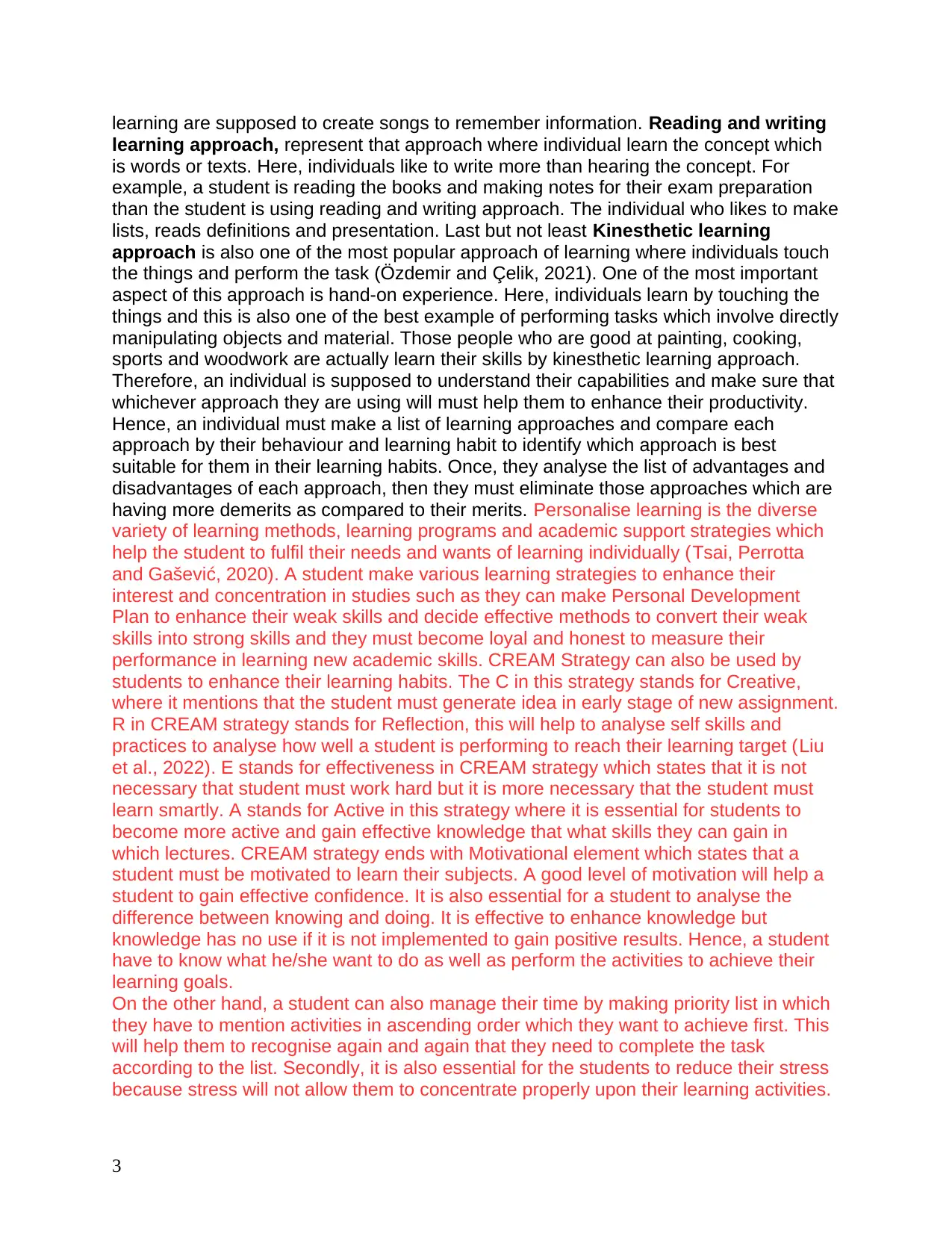
learning are supposed to create songs to remember information. Reading and writing
learning approach, represent that approach where individual learn the concept which
is words or texts. Here, individuals like to write more than hearing the concept. For
example, a student is reading the books and making notes for their exam preparation
than the student is using reading and writing approach. The individual who likes to make
lists, reads definitions and presentation. Last but not least Kinesthetic learning
approach is also one of the most popular approach of learning where individuals touch
the things and perform the task (Özdemir and Çelik, 2021). One of the most important
aspect of this approach is hand-on experience. Here, individuals learn by touching the
things and this is also one of the best example of performing tasks which involve directly
manipulating objects and material. Those people who are good at painting, cooking,
sports and woodwork are actually learn their skills by kinesthetic learning approach.
Therefore, an individual is supposed to understand their capabilities and make sure that
whichever approach they are using will must help them to enhance their productivity.
Hence, an individual must make a list of learning approaches and compare each
approach by their behaviour and learning habit to identify which approach is best
suitable for them in their learning habits. Once, they analyse the list of advantages and
disadvantages of each approach, then they must eliminate those approaches which are
having more demerits as compared to their merits. Personalise learning is the diverse
variety of learning methods, learning programs and academic support strategies which
help the student to fulfil their needs and wants of learning individually (Tsai, Perrotta
and Gašević, 2020). A student make various learning strategies to enhance their
interest and concentration in studies such as they can make Personal Development
Plan to enhance their weak skills and decide effective methods to convert their weak
skills into strong skills and they must become loyal and honest to measure their
performance in learning new academic skills. CREAM Strategy can also be used by
students to enhance their learning habits. The C in this strategy stands for Creative,
where it mentions that the student must generate idea in early stage of new assignment.
R in CREAM strategy stands for Reflection, this will help to analyse self skills and
practices to analyse how well a student is performing to reach their learning target (Liu
et al., 2022). E stands for effectiveness in CREAM strategy which states that it is not
necessary that student must work hard but it is more necessary that the student must
learn smartly. A stands for Active in this strategy where it is essential for students to
become more active and gain effective knowledge that what skills they can gain in
which lectures. CREAM strategy ends with Motivational element which states that a
student must be motivated to learn their subjects. A good level of motivation will help a
student to gain effective confidence. It is also essential for a student to analyse the
difference between knowing and doing. It is effective to enhance knowledge but
knowledge has no use if it is not implemented to gain positive results. Hence, a student
have to know what he/she want to do as well as perform the activities to achieve their
learning goals.
On the other hand, a student can also manage their time by making priority list in which
they have to mention activities in ascending order which they want to achieve first. This
will help them to recognise again and again that they need to complete the task
according to the list. Secondly, it is also essential for the students to reduce their stress
because stress will not allow them to concentrate properly upon their learning activities.
3
learning approach, represent that approach where individual learn the concept which
is words or texts. Here, individuals like to write more than hearing the concept. For
example, a student is reading the books and making notes for their exam preparation
than the student is using reading and writing approach. The individual who likes to make
lists, reads definitions and presentation. Last but not least Kinesthetic learning
approach is also one of the most popular approach of learning where individuals touch
the things and perform the task (Özdemir and Çelik, 2021). One of the most important
aspect of this approach is hand-on experience. Here, individuals learn by touching the
things and this is also one of the best example of performing tasks which involve directly
manipulating objects and material. Those people who are good at painting, cooking,
sports and woodwork are actually learn their skills by kinesthetic learning approach.
Therefore, an individual is supposed to understand their capabilities and make sure that
whichever approach they are using will must help them to enhance their productivity.
Hence, an individual must make a list of learning approaches and compare each
approach by their behaviour and learning habit to identify which approach is best
suitable for them in their learning habits. Once, they analyse the list of advantages and
disadvantages of each approach, then they must eliminate those approaches which are
having more demerits as compared to their merits. Personalise learning is the diverse
variety of learning methods, learning programs and academic support strategies which
help the student to fulfil their needs and wants of learning individually (Tsai, Perrotta
and Gašević, 2020). A student make various learning strategies to enhance their
interest and concentration in studies such as they can make Personal Development
Plan to enhance their weak skills and decide effective methods to convert their weak
skills into strong skills and they must become loyal and honest to measure their
performance in learning new academic skills. CREAM Strategy can also be used by
students to enhance their learning habits. The C in this strategy stands for Creative,
where it mentions that the student must generate idea in early stage of new assignment.
R in CREAM strategy stands for Reflection, this will help to analyse self skills and
practices to analyse how well a student is performing to reach their learning target (Liu
et al., 2022). E stands for effectiveness in CREAM strategy which states that it is not
necessary that student must work hard but it is more necessary that the student must
learn smartly. A stands for Active in this strategy where it is essential for students to
become more active and gain effective knowledge that what skills they can gain in
which lectures. CREAM strategy ends with Motivational element which states that a
student must be motivated to learn their subjects. A good level of motivation will help a
student to gain effective confidence. It is also essential for a student to analyse the
difference between knowing and doing. It is effective to enhance knowledge but
knowledge has no use if it is not implemented to gain positive results. Hence, a student
have to know what he/she want to do as well as perform the activities to achieve their
learning goals.
On the other hand, a student can also manage their time by making priority list in which
they have to mention activities in ascending order which they want to achieve first. This
will help them to recognise again and again that they need to complete the task
according to the list. Secondly, it is also essential for the students to reduce their stress
because stress will not allow them to concentrate properly upon their learning activities.
3
You're viewing a preview
Unlock full access by subscribing today!
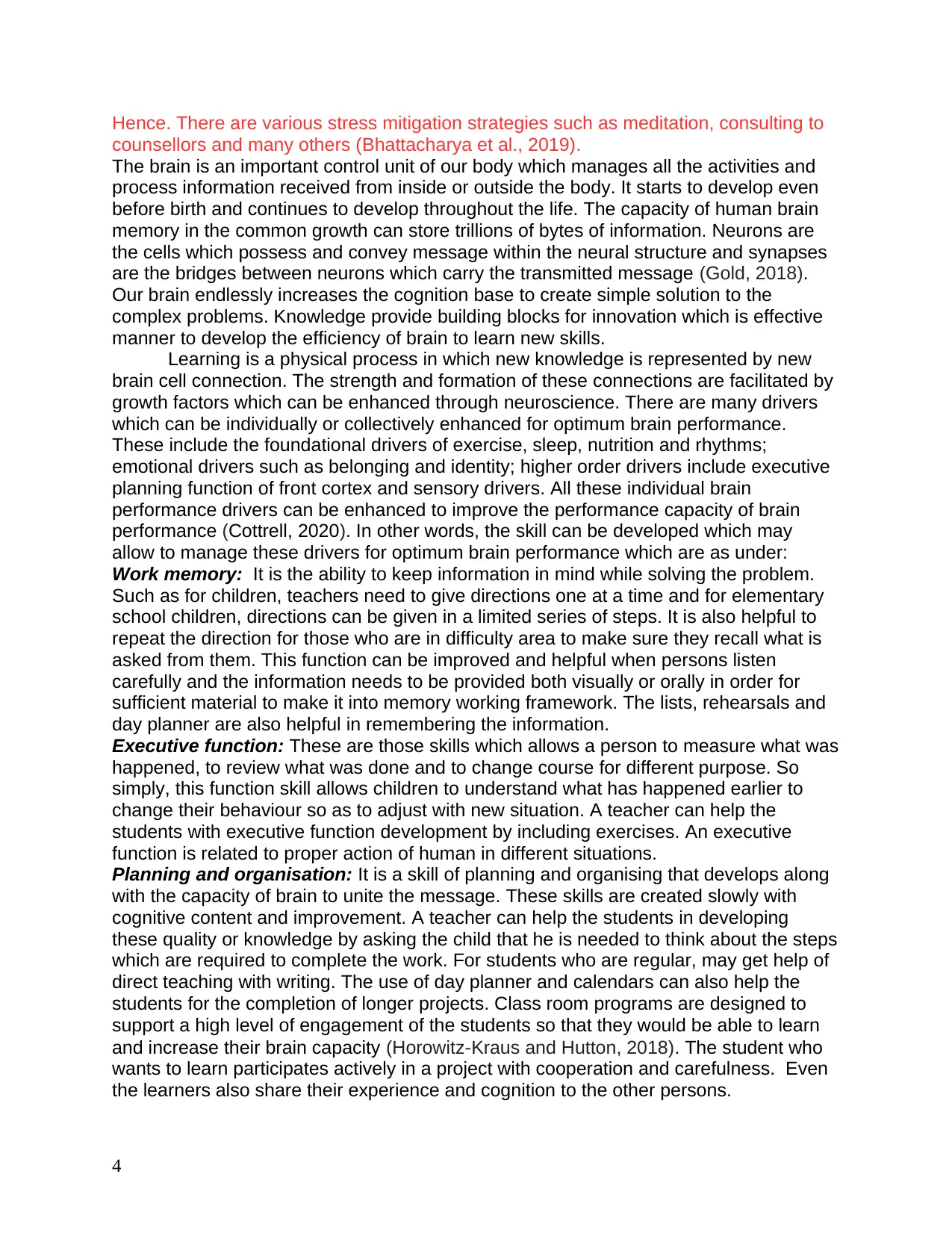
Hence. There are various stress mitigation strategies such as meditation, consulting to
counsellors and many others (Bhattacharya et al., 2019).
The brain is an important control unit of our body which manages all the activities and
process information received from inside or outside the body. It starts to develop even
before birth and continues to develop throughout the life. The capacity of human brain
memory in the common growth can store trillions of bytes of information. Neurons are
the cells which possess and convey message within the neural structure and synapses
are the bridges between neurons which carry the transmitted message (Gold, 2018).
Our brain endlessly increases the cognition base to create simple solution to the
complex problems. Knowledge provide building blocks for innovation which is effective
manner to develop the efficiency of brain to learn new skills.
Learning is a physical process in which new knowledge is represented by new
brain cell connection. The strength and formation of these connections are facilitated by
growth factors which can be enhanced through neuroscience. There are many drivers
which can be individually or collectively enhanced for optimum brain performance.
These include the foundational drivers of exercise, sleep, nutrition and rhythms;
emotional drivers such as belonging and identity; higher order drivers include executive
planning function of front cortex and sensory drivers. All these individual brain
performance drivers can be enhanced to improve the performance capacity of brain
performance (Cottrell, 2020). In other words, the skill can be developed which may
allow to manage these drivers for optimum brain performance which are as under:
Work memory: It is the ability to keep information in mind while solving the problem.
Such as for children, teachers need to give directions one at a time and for elementary
school children, directions can be given in a limited series of steps. It is also helpful to
repeat the direction for those who are in difficulty area to make sure they recall what is
asked from them. This function can be improved and helpful when persons listen
carefully and the information needs to be provided both visually or orally in order for
sufficient material to make it into memory working framework. The lists, rehearsals and
day planner are also helpful in remembering the information.
Executive function: These are those skills which allows a person to measure what was
happened, to review what was done and to change course for different purpose. So
simply, this function skill allows children to understand what has happened earlier to
change their behaviour so as to adjust with new situation. A teacher can help the
students with executive function development by including exercises. An executive
function is related to proper action of human in different situations.
Planning and organisation: It is a skill of planning and organising that develops along
with the capacity of brain to unite the message. These skills are created slowly with
cognitive content and improvement. A teacher can help the students in developing
these quality or knowledge by asking the child that he is needed to think about the steps
which are required to complete the work. For students who are regular, may get help of
direct teaching with writing. The use of day planner and calendars can also help the
students for the completion of longer projects. Class room programs are designed to
support a high level of engagement of the students so that they would be able to learn
and increase their brain capacity (Horowitz‐Kraus and Hutton, 2018). The student who
wants to learn participates actively in a project with cooperation and carefulness. Even
the learners also share their experience and cognition to the other persons.
4
counsellors and many others (Bhattacharya et al., 2019).
The brain is an important control unit of our body which manages all the activities and
process information received from inside or outside the body. It starts to develop even
before birth and continues to develop throughout the life. The capacity of human brain
memory in the common growth can store trillions of bytes of information. Neurons are
the cells which possess and convey message within the neural structure and synapses
are the bridges between neurons which carry the transmitted message (Gold, 2018).
Our brain endlessly increases the cognition base to create simple solution to the
complex problems. Knowledge provide building blocks for innovation which is effective
manner to develop the efficiency of brain to learn new skills.
Learning is a physical process in which new knowledge is represented by new
brain cell connection. The strength and formation of these connections are facilitated by
growth factors which can be enhanced through neuroscience. There are many drivers
which can be individually or collectively enhanced for optimum brain performance.
These include the foundational drivers of exercise, sleep, nutrition and rhythms;
emotional drivers such as belonging and identity; higher order drivers include executive
planning function of front cortex and sensory drivers. All these individual brain
performance drivers can be enhanced to improve the performance capacity of brain
performance (Cottrell, 2020). In other words, the skill can be developed which may
allow to manage these drivers for optimum brain performance which are as under:
Work memory: It is the ability to keep information in mind while solving the problem.
Such as for children, teachers need to give directions one at a time and for elementary
school children, directions can be given in a limited series of steps. It is also helpful to
repeat the direction for those who are in difficulty area to make sure they recall what is
asked from them. This function can be improved and helpful when persons listen
carefully and the information needs to be provided both visually or orally in order for
sufficient material to make it into memory working framework. The lists, rehearsals and
day planner are also helpful in remembering the information.
Executive function: These are those skills which allows a person to measure what was
happened, to review what was done and to change course for different purpose. So
simply, this function skill allows children to understand what has happened earlier to
change their behaviour so as to adjust with new situation. A teacher can help the
students with executive function development by including exercises. An executive
function is related to proper action of human in different situations.
Planning and organisation: It is a skill of planning and organising that develops along
with the capacity of brain to unite the message. These skills are created slowly with
cognitive content and improvement. A teacher can help the students in developing
these quality or knowledge by asking the child that he is needed to think about the steps
which are required to complete the work. For students who are regular, may get help of
direct teaching with writing. The use of day planner and calendars can also help the
students for the completion of longer projects. Class room programs are designed to
support a high level of engagement of the students so that they would be able to learn
and increase their brain capacity (Horowitz‐Kraus and Hutton, 2018). The student who
wants to learn participates actively in a project with cooperation and carefulness. Even
the learners also share their experience and cognition to the other persons.
4
Paraphrase This Document
Need a fresh take? Get an instant paraphrase of this document with our AI Paraphraser
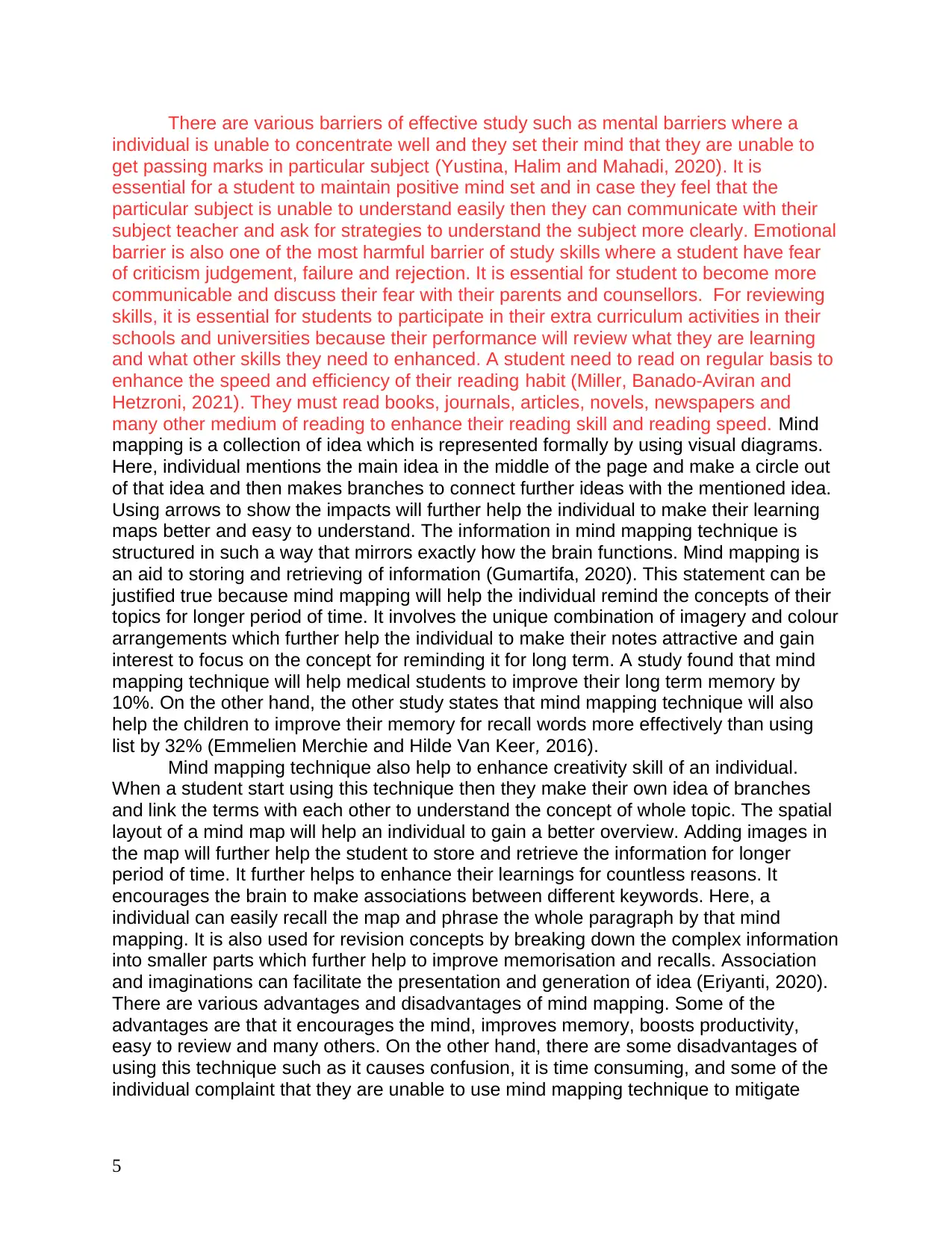
There are various barriers of effective study such as mental barriers where a
individual is unable to concentrate well and they set their mind that they are unable to
get passing marks in particular subject (Yustina, Halim and Mahadi, 2020). It is
essential for a student to maintain positive mind set and in case they feel that the
particular subject is unable to understand easily then they can communicate with their
subject teacher and ask for strategies to understand the subject more clearly. Emotional
barrier is also one of the most harmful barrier of study skills where a student have fear
of criticism judgement, failure and rejection. It is essential for student to become more
communicable and discuss their fear with their parents and counsellors. For reviewing
skills, it is essential for students to participate in their extra curriculum activities in their
schools and universities because their performance will review what they are learning
and what other skills they need to enhanced. A student need to read on regular basis to
enhance the speed and efficiency of their reading habit (Miller, Banado-Aviran and
Hetzroni, 2021). They must read books, journals, articles, novels, newspapers and
many other medium of reading to enhance their reading skill and reading speed. Mind
mapping is a collection of idea which is represented formally by using visual diagrams.
Here, individual mentions the main idea in the middle of the page and make a circle out
of that idea and then makes branches to connect further ideas with the mentioned idea.
Using arrows to show the impacts will further help the individual to make their learning
maps better and easy to understand. The information in mind mapping technique is
structured in such a way that mirrors exactly how the brain functions. Mind mapping is
an aid to storing and retrieving of information (Gumartifa, 2020). This statement can be
justified true because mind mapping will help the individual remind the concepts of their
topics for longer period of time. It involves the unique combination of imagery and colour
arrangements which further help the individual to make their notes attractive and gain
interest to focus on the concept for reminding it for long term. A study found that mind
mapping technique will help medical students to improve their long term memory by
10%. On the other hand, the other study states that mind mapping technique will also
help the children to improve their memory for recall words more effectively than using
list by 32% (Emmelien Merchie and Hilde Van Keer, 2016).
Mind mapping technique also help to enhance creativity skill of an individual.
When a student start using this technique then they make their own idea of branches
and link the terms with each other to understand the concept of whole topic. The spatial
layout of a mind map will help an individual to gain a better overview. Adding images in
the map will further help the student to store and retrieve the information for longer
period of time. It further helps to enhance their learnings for countless reasons. It
encourages the brain to make associations between different keywords. Here, a
individual can easily recall the map and phrase the whole paragraph by that mind
mapping. It is also used for revision concepts by breaking down the complex information
into smaller parts which further help to improve memorisation and recalls. Association
and imaginations can facilitate the presentation and generation of idea (Eriyanti, 2020).
There are various advantages and disadvantages of mind mapping. Some of the
advantages are that it encourages the mind, improves memory, boosts productivity,
easy to review and many others. On the other hand, there are some disadvantages of
using this technique such as it causes confusion, it is time consuming, and some of the
individual complaint that they are unable to use mind mapping technique to mitigate
5
individual is unable to concentrate well and they set their mind that they are unable to
get passing marks in particular subject (Yustina, Halim and Mahadi, 2020). It is
essential for a student to maintain positive mind set and in case they feel that the
particular subject is unable to understand easily then they can communicate with their
subject teacher and ask for strategies to understand the subject more clearly. Emotional
barrier is also one of the most harmful barrier of study skills where a student have fear
of criticism judgement, failure and rejection. It is essential for student to become more
communicable and discuss their fear with their parents and counsellors. For reviewing
skills, it is essential for students to participate in their extra curriculum activities in their
schools and universities because their performance will review what they are learning
and what other skills they need to enhanced. A student need to read on regular basis to
enhance the speed and efficiency of their reading habit (Miller, Banado-Aviran and
Hetzroni, 2021). They must read books, journals, articles, novels, newspapers and
many other medium of reading to enhance their reading skill and reading speed. Mind
mapping is a collection of idea which is represented formally by using visual diagrams.
Here, individual mentions the main idea in the middle of the page and make a circle out
of that idea and then makes branches to connect further ideas with the mentioned idea.
Using arrows to show the impacts will further help the individual to make their learning
maps better and easy to understand. The information in mind mapping technique is
structured in such a way that mirrors exactly how the brain functions. Mind mapping is
an aid to storing and retrieving of information (Gumartifa, 2020). This statement can be
justified true because mind mapping will help the individual remind the concepts of their
topics for longer period of time. It involves the unique combination of imagery and colour
arrangements which further help the individual to make their notes attractive and gain
interest to focus on the concept for reminding it for long term. A study found that mind
mapping technique will help medical students to improve their long term memory by
10%. On the other hand, the other study states that mind mapping technique will also
help the children to improve their memory for recall words more effectively than using
list by 32% (Emmelien Merchie and Hilde Van Keer, 2016).
Mind mapping technique also help to enhance creativity skill of an individual.
When a student start using this technique then they make their own idea of branches
and link the terms with each other to understand the concept of whole topic. The spatial
layout of a mind map will help an individual to gain a better overview. Adding images in
the map will further help the student to store and retrieve the information for longer
period of time. It further helps to enhance their learnings for countless reasons. It
encourages the brain to make associations between different keywords. Here, a
individual can easily recall the map and phrase the whole paragraph by that mind
mapping. It is also used for revision concepts by breaking down the complex information
into smaller parts which further help to improve memorisation and recalls. Association
and imaginations can facilitate the presentation and generation of idea (Eriyanti, 2020).
There are various advantages and disadvantages of mind mapping. Some of the
advantages are that it encourages the mind, improves memory, boosts productivity,
easy to review and many others. On the other hand, there are some disadvantages of
using this technique such as it causes confusion, it is time consuming, and some of the
individual complaint that they are unable to use mind mapping technique to mitigate
5
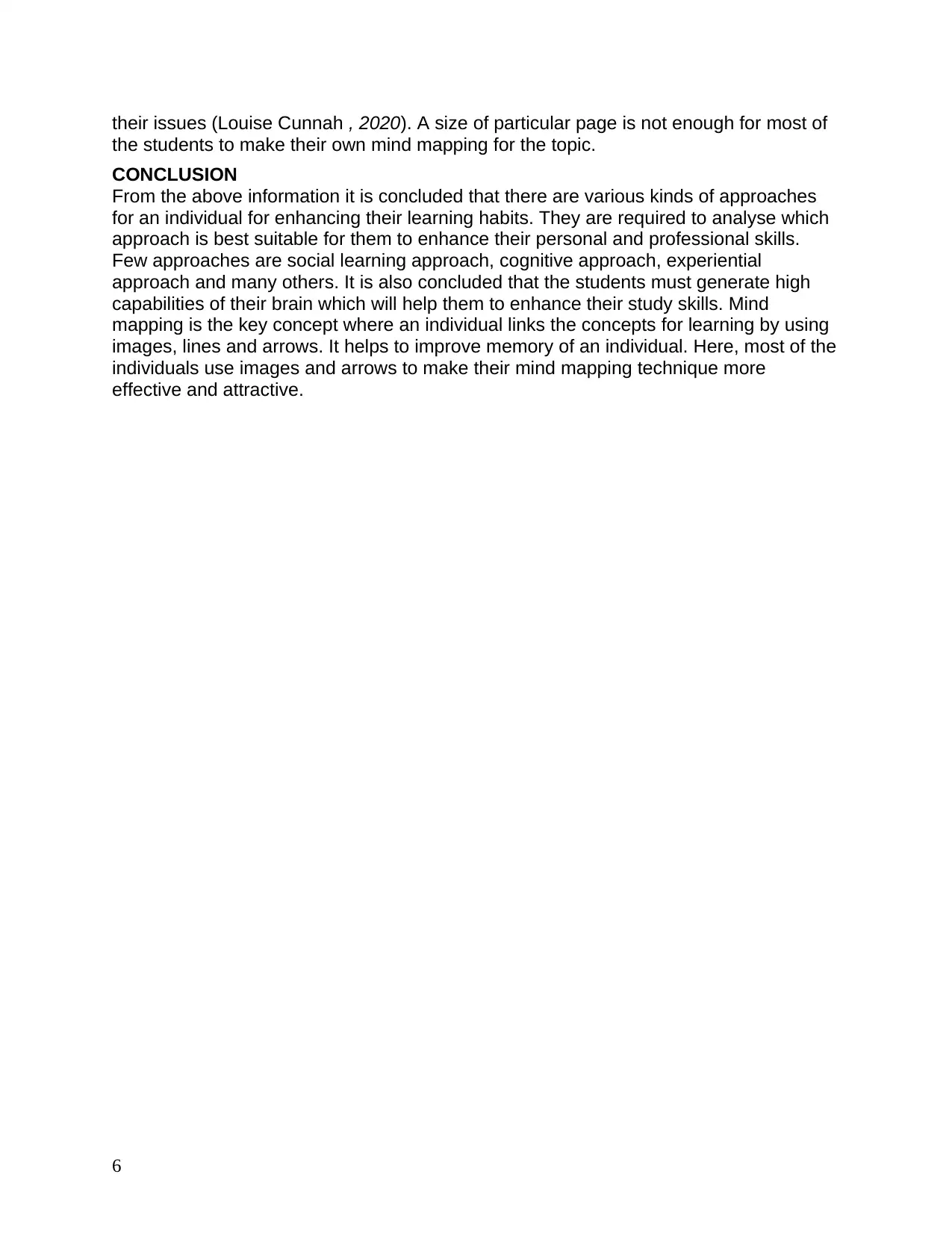
their issues (Louise Cunnah , 2020). A size of particular page is not enough for most of
the students to make their own mind mapping for the topic.
CONCLUSION
From the above information it is concluded that there are various kinds of approaches
for an individual for enhancing their learning habits. They are required to analyse which
approach is best suitable for them to enhance their personal and professional skills.
Few approaches are social learning approach, cognitive approach, experiential
approach and many others. It is also concluded that the students must generate high
capabilities of their brain which will help them to enhance their study skills. Mind
mapping is the key concept where an individual links the concepts for learning by using
images, lines and arrows. It helps to improve memory of an individual. Here, most of the
individuals use images and arrows to make their mind mapping technique more
effective and attractive.
6
the students to make their own mind mapping for the topic.
CONCLUSION
From the above information it is concluded that there are various kinds of approaches
for an individual for enhancing their learning habits. They are required to analyse which
approach is best suitable for them to enhance their personal and professional skills.
Few approaches are social learning approach, cognitive approach, experiential
approach and many others. It is also concluded that the students must generate high
capabilities of their brain which will help them to enhance their study skills. Mind
mapping is the key concept where an individual links the concepts for learning by using
images, lines and arrows. It helps to improve memory of an individual. Here, most of the
individuals use images and arrows to make their mind mapping technique more
effective and attractive.
6
You're viewing a preview
Unlock full access by subscribing today!
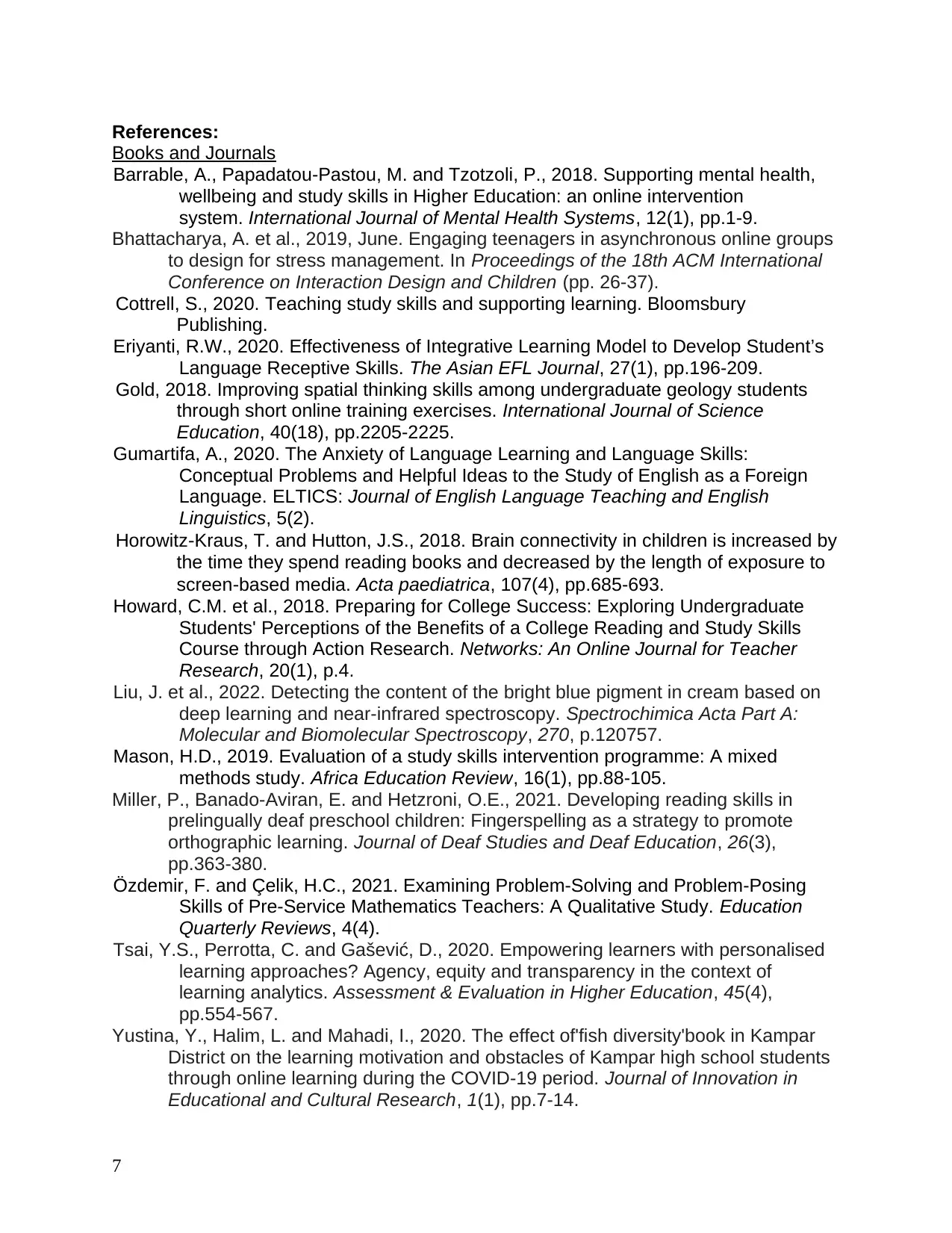
References:
Books and Journals
Barrable, A., Papadatou-Pastou, M. and Tzotzoli, P., 2018. Supporting mental health,
wellbeing and study skills in Higher Education: an online intervention
system. International Journal of Mental Health Systems, 12(1), pp.1-9.
Bhattacharya, A. et al., 2019, June. Engaging teenagers in asynchronous online groups
to design for stress management. In Proceedings of the 18th ACM International
Conference on Interaction Design and Children (pp. 26-37).
Cottrell, S., 2020. Teaching study skills and supporting learning. Bloomsbury
Publishing.
Eriyanti, R.W., 2020. Effectiveness of Integrative Learning Model to Develop Student’s
Language Receptive Skills. The Asian EFL Journal, 27(1), pp.196-209.
Gold, 2018. Improving spatial thinking skills among undergraduate geology students
through short online training exercises. International Journal of Science
Education, 40(18), pp.2205-2225.
Gumartifa, A., 2020. The Anxiety of Language Learning and Language Skills:
Conceptual Problems and Helpful Ideas to the Study of English as a Foreign
Language. ELTICS: Journal of English Language Teaching and English
Linguistics, 5(2).
Horowitz‐Kraus, T. and Hutton, J.S., 2018. Brain connectivity in children is increased by
the time they spend reading books and decreased by the length of exposure to
screen‐based media. Acta paediatrica, 107(4), pp.685-693.
Howard, C.M. et al., 2018. Preparing for College Success: Exploring Undergraduate
Students' Perceptions of the Benefits of a College Reading and Study Skills
Course through Action Research. Networks: An Online Journal for Teacher
Research, 20(1), p.4.
Liu, J. et al., 2022. Detecting the content of the bright blue pigment in cream based on
deep learning and near-infrared spectroscopy. Spectrochimica Acta Part A:
Molecular and Biomolecular Spectroscopy, 270, p.120757.
Mason, H.D., 2019. Evaluation of a study skills intervention programme: A mixed
methods study. Africa Education Review, 16(1), pp.88-105.
Miller, P., Banado-Aviran, E. and Hetzroni, O.E., 2021. Developing reading skills in
prelingually deaf preschool children: Fingerspelling as a strategy to promote
orthographic learning. Journal of Deaf Studies and Deaf Education, 26(3),
pp.363-380.
Özdemir, F. and Çelik, H.C., 2021. Examining Problem-Solving and Problem-Posing
Skills of Pre-Service Mathematics Teachers: A Qualitative Study. Education
Quarterly Reviews, 4(4).
Tsai, Y.S., Perrotta, C. and Gašević, D., 2020. Empowering learners with personalised
learning approaches? Agency, equity and transparency in the context of
learning analytics. Assessment & Evaluation in Higher Education, 45(4),
pp.554-567.
Yustina, Y., Halim, L. and Mahadi, I., 2020. The effect of'fish diversity'book in Kampar
District on the learning motivation and obstacles of Kampar high school students
through online learning during the COVID-19 period. Journal of Innovation in
Educational and Cultural Research, 1(1), pp.7-14.
7
Books and Journals
Barrable, A., Papadatou-Pastou, M. and Tzotzoli, P., 2018. Supporting mental health,
wellbeing and study skills in Higher Education: an online intervention
system. International Journal of Mental Health Systems, 12(1), pp.1-9.
Bhattacharya, A. et al., 2019, June. Engaging teenagers in asynchronous online groups
to design for stress management. In Proceedings of the 18th ACM International
Conference on Interaction Design and Children (pp. 26-37).
Cottrell, S., 2020. Teaching study skills and supporting learning. Bloomsbury
Publishing.
Eriyanti, R.W., 2020. Effectiveness of Integrative Learning Model to Develop Student’s
Language Receptive Skills. The Asian EFL Journal, 27(1), pp.196-209.
Gold, 2018. Improving spatial thinking skills among undergraduate geology students
through short online training exercises. International Journal of Science
Education, 40(18), pp.2205-2225.
Gumartifa, A., 2020. The Anxiety of Language Learning and Language Skills:
Conceptual Problems and Helpful Ideas to the Study of English as a Foreign
Language. ELTICS: Journal of English Language Teaching and English
Linguistics, 5(2).
Horowitz‐Kraus, T. and Hutton, J.S., 2018. Brain connectivity in children is increased by
the time they spend reading books and decreased by the length of exposure to
screen‐based media. Acta paediatrica, 107(4), pp.685-693.
Howard, C.M. et al., 2018. Preparing for College Success: Exploring Undergraduate
Students' Perceptions of the Benefits of a College Reading and Study Skills
Course through Action Research. Networks: An Online Journal for Teacher
Research, 20(1), p.4.
Liu, J. et al., 2022. Detecting the content of the bright blue pigment in cream based on
deep learning and near-infrared spectroscopy. Spectrochimica Acta Part A:
Molecular and Biomolecular Spectroscopy, 270, p.120757.
Mason, H.D., 2019. Evaluation of a study skills intervention programme: A mixed
methods study. Africa Education Review, 16(1), pp.88-105.
Miller, P., Banado-Aviran, E. and Hetzroni, O.E., 2021. Developing reading skills in
prelingually deaf preschool children: Fingerspelling as a strategy to promote
orthographic learning. Journal of Deaf Studies and Deaf Education, 26(3),
pp.363-380.
Özdemir, F. and Çelik, H.C., 2021. Examining Problem-Solving and Problem-Posing
Skills of Pre-Service Mathematics Teachers: A Qualitative Study. Education
Quarterly Reviews, 4(4).
Tsai, Y.S., Perrotta, C. and Gašević, D., 2020. Empowering learners with personalised
learning approaches? Agency, equity and transparency in the context of
learning analytics. Assessment & Evaluation in Higher Education, 45(4),
pp.554-567.
Yustina, Y., Halim, L. and Mahadi, I., 2020. The effect of'fish diversity'book in Kampar
District on the learning motivation and obstacles of Kampar high school students
through online learning during the COVID-19 period. Journal of Innovation in
Educational and Cultural Research, 1(1), pp.7-14.
7
Paraphrase This Document
Need a fresh take? Get an instant paraphrase of this document with our AI Paraphraser
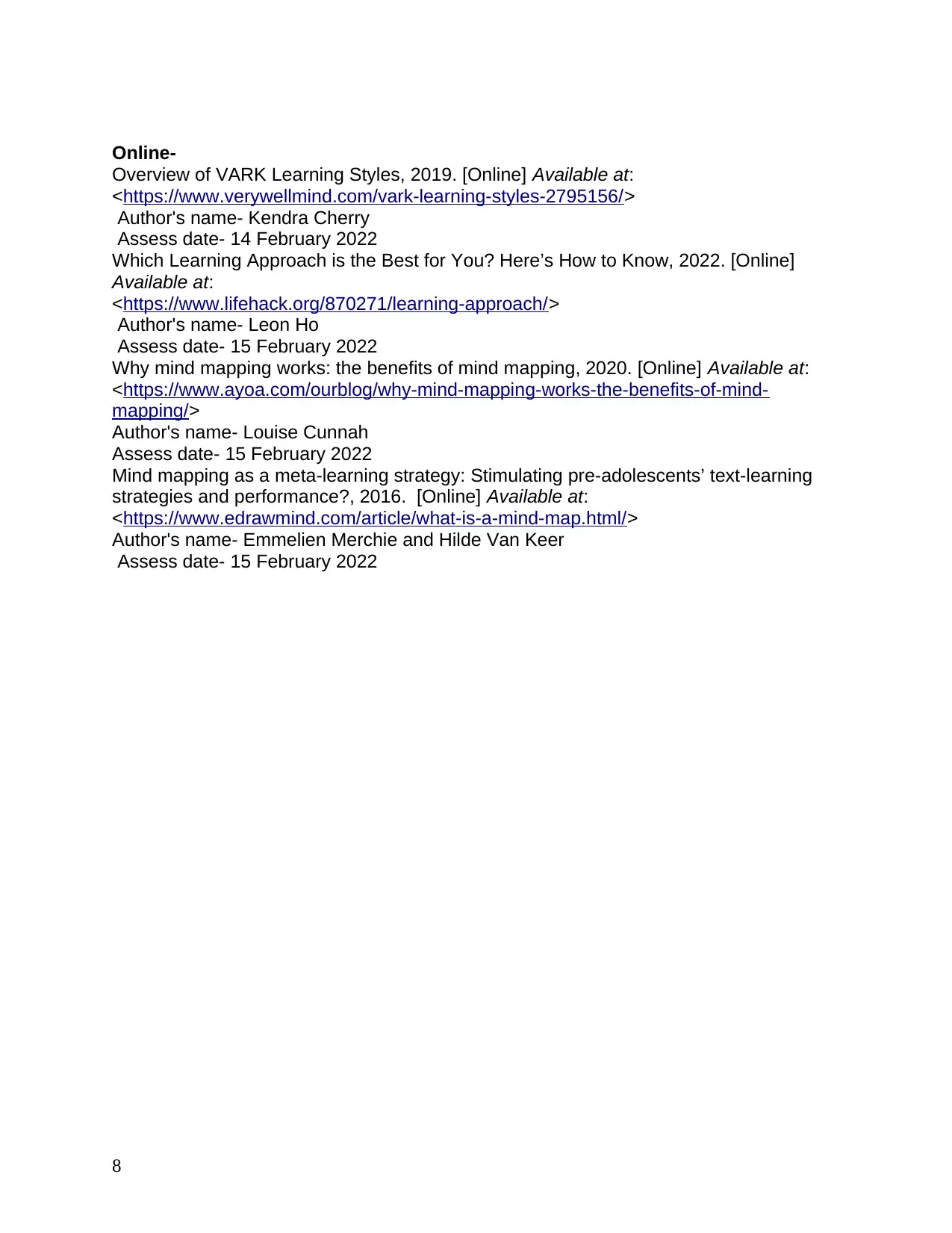
Online-
Overview of VARK Learning Styles, 2019. [Online] Available at:
<https://www.verywellmind.com/vark-learning-styles-2795156/>
Author's name- Kendra Cherry
Assess date- 14 February 2022
Which Learning Approach is the Best for You? Here’s How to Know, 2022. [Online]
Available at:
<https://www.lifehack.org/870271/learning-approach/>
Author's name- Leon Ho
Assess date- 15 February 2022
Why mind mapping works: the benefits of mind mapping, 2020. [Online] Available at:
<https://www.ayoa.com/ourblog/why-mind-mapping-works-the-benefits-of-mind-
mapping/>
Author's name- Louise Cunnah
Assess date- 15 February 2022
Mind mapping as a meta-learning strategy: Stimulating pre-adolescents’ text-learning
strategies and performance?, 2016. [Online] Available at:
<https://www.edrawmind.com/article/what-is-a-mind-map.html/>
Author's name- Emmelien Merchie and Hilde Van Keer
Assess date- 15 February 2022
8
Overview of VARK Learning Styles, 2019. [Online] Available at:
<https://www.verywellmind.com/vark-learning-styles-2795156/>
Author's name- Kendra Cherry
Assess date- 14 February 2022
Which Learning Approach is the Best for You? Here’s How to Know, 2022. [Online]
Available at:
<https://www.lifehack.org/870271/learning-approach/>
Author's name- Leon Ho
Assess date- 15 February 2022
Why mind mapping works: the benefits of mind mapping, 2020. [Online] Available at:
<https://www.ayoa.com/ourblog/why-mind-mapping-works-the-benefits-of-mind-
mapping/>
Author's name- Louise Cunnah
Assess date- 15 February 2022
Mind mapping as a meta-learning strategy: Stimulating pre-adolescents’ text-learning
strategies and performance?, 2016. [Online] Available at:
<https://www.edrawmind.com/article/what-is-a-mind-map.html/>
Author's name- Emmelien Merchie and Hilde Van Keer
Assess date- 15 February 2022
8
1 out of 8
Related Documents
Your All-in-One AI-Powered Toolkit for Academic Success.
+13062052269
info@desklib.com
Available 24*7 on WhatsApp / Email
![[object Object]](/_next/static/media/star-bottom.7253800d.svg)
Unlock your academic potential
© 2024 | Zucol Services PVT LTD | All rights reserved.



